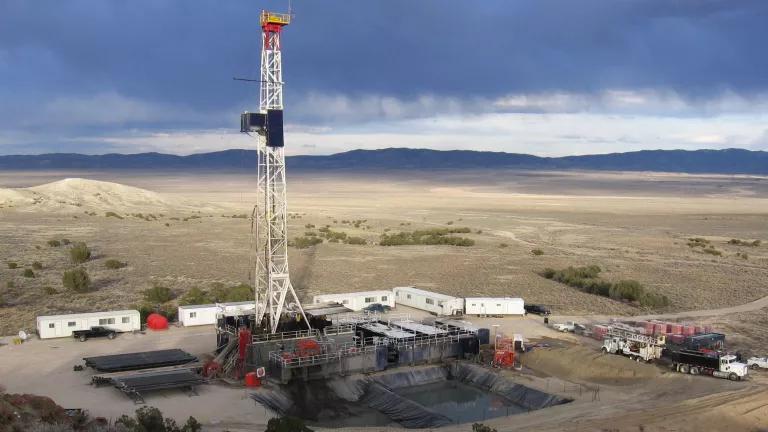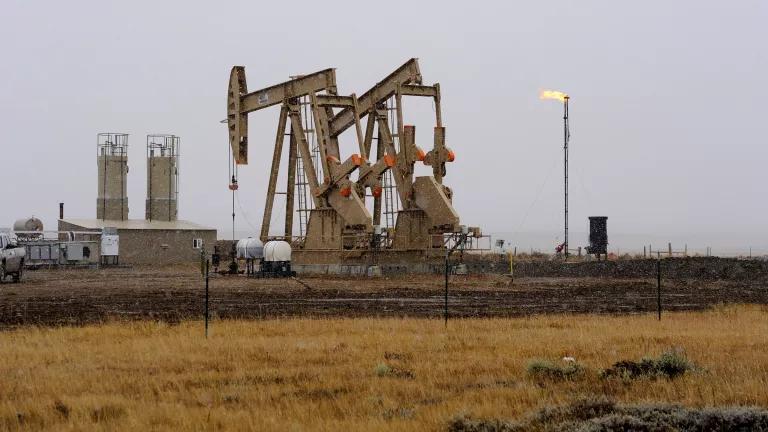A Place for Fossils, Not Fuels
The Biden administration made news this week when it announced it will consider protecting a portion of the Greater Chaco Region in New Mexico from new oil and gas drilling.
The Biden administration made news this week when it announced it will consider protecting a portion of the Greater Chaco Region in New Mexico from new oil and gas drilling.
This is a region the fossil fuel industry has had its way with for years.
What’s more, numerous subsidies in the U.S. tax code encourage companies to extract oil, gas, and coal. Today we know how destructive it is to incentivize that: extraction pollutes our communities, destroys nature, and fuels climate change. Often lost in the debate over esoteric tax policy is the way this industry harms people and communities.
NRDC has worked with local leaders in the Greater Chaco Region and three other communities around the country to understand more clearly how incentivizing the fossil fuel industry harms people. Hearing stories like these from Wilmington, CA; St. James Parish, LA; Washington County, PA; and Chaco—can help all of us grasp the urgency of eliminating fossil fuel subsidies.
Thank you to Diné C.A.R.E for telling the story of the adverse impacts of fossil fuel extraction in the Greater Chaco Region. For more information on its work to protect public health, nature and human rights in New Mexico communities please visit https://www.dine-care.org/.
Greater Chaco Region, New Mexico
The Greater Chaco region of northwest New Mexico is home to a stunning and sensitive landscape, including Chaco Culture National Historical Park, and surrounding lands that are sacred to the Diné people. Much of the land in this northwest corner of the state is part of the Navajo Nation. The Navajo Nation is divided into chapters, which are local tribal government entities, and three of the chapters in northwest New Mexico—Counselor, Ojo Encino, and Torreon chapters—have joined together to form the Tri-Chapter Alliance to protect their uniquely historic rural area. Approximately 3,133 individuals live in the Tri-Chapter region; more than 80 percent are Diné people with Navajo heritage.[i]
While the area is known for its many cultural and historical sites and landscapes, the Tri-Chapter region is also a hotspot for oil and gas production. Local communities endure daily the adverse health, safety, and environmental impacts of oil and gas activities at well pads, industrial wastewater pits, storage tanks, pipelines, and dirt access roads for the many tankers and trucks involved in all of these activities. In New Mexico, around 90 percent of lands are already leased for oil and gas operations and around 40,000 existing oil and wells have already been drilled in the Greater Chaco Region alone.[ii]
Most residents of the Counselor Chapter live within one mile of well sites, pipelines, and other gas and oil infrastructure. In 2018 the Counselor Chapter Health Impact Assessment (HIA) Committee conducted a wellness survey that found greater than 80% of participating Diné residents reported health concerns including respiratory symptoms, headaches, itching and burning eyes and skin, and nosebleeds.[iii] Air quality monitoring conducted in 2018 detected particulate matter at elevated levels that can place residents at greater risk for respiratory and cardiovascular diseases, as well as toxic chemicals, including volatile organic compounds, that are known to cause cancer.[iv] One well site, located near Lybrook Elementary School, indicated elevated levels of hydrogen sulfide, a toxic pollutant that can cause serious health effects.[v] There are approximately 21 wells within one mile of the school.[vi]
Kendra Pinto is an organizer with Diné C.A.R.E., an organization working with many Navajo communities affected by energy and environmental issues. Also a resident of Counselor Chapter, Kendra observes: “People get headaches in the morning, we have cancer out here now, people are being diagnosed with cardio diseases, and asthma cases have gone up.”
Even after all of this harm to this rural, vulnerable community, the U.S. Bureau of Land Management (BLM) proposed in a resource management plan amendment even more oil and gas development in the region, with projections of over 3,000 new wells in the planning area. This approach would ignore community concerns about threats to drinking water sources, hazardous air pollution, and the lack of water infrastructure and environmental justice in a community of color where fewer than half of Tribal households have fixed broadband access. Some families have to travel to purchase water for household use and for livestock.
Earlier this week, President Biden and Secretary of the Interior Debra Haaland announced that the Department will propose to withdraw federal lands from new oil and gas leasing for 20 years within a 10-mile radius around Chaco Culture National Historical Park. However, drilling on existing valid leases in the region could continue.
The Tri-Chapter Alliance and Diné C.A.R.E. are working to stop any new oil and gas operations in the Greater Chaco region. For more information on how to help frontline community efforts, please visit https://www.dine-care.org/.
Congress Must Act to End Fossil Fuel Freebies Now
Across the country, decision-makers must stop the expansion of fossil fuel infrastructure in regions like Greater Chaco. And at the federal level, Congress must also ensure that that we do not further incentivize this dirty and destructive industry through taxpayer dollars. Ending fossil fuel giveaways is a no-brainer and an essential step in the effort to eliminate the industry’s threat to communities, nature, and the planet’s future.
[i]U.S. Census Bureau, Navajo Population Profile 2010 U.S. Census, December 2013, https://www.nec.navajo-nsn.gov/Portals/0/Reports/NN2010PopulationProfile.pdf
[ii] UCLA Institute of the Environment and Sustainability for WildEarth Guardians, Impacts of oil and gas drilling on indigenous communities in new Mexico’s Greater Chaco landscape, September 2020, https://www.ioes.ucla.edu/wp-content/uploads/2020/09/ucla-ioes-practicum-impacts-of-oil-and-gas-on-indigenous-communities-in-new-mexico-final-report-9-2020.pdf
[iii] Counselor Health Impact Assessment - K’é Bee Hózhǫǫgo Iiná Silá Committee, A Cultural, Spiritual and Health Impact Assessment Of Oil Drilling Operations in the Navajo Nation area of Counselor, Torreon and Ojo Encino Chapters, 2021
[iv] Tsosie D, Seamster T, Grant S, James-Tohe, H, Velivis, B, et al., A Cultural, Spiritual and Health Impact Assessment of Oil Drilling Operations in the Navajo Nation Area of Counselor, Torreon and Ojo Encino Chapters, 2021.
[vi] Ibid., 29





